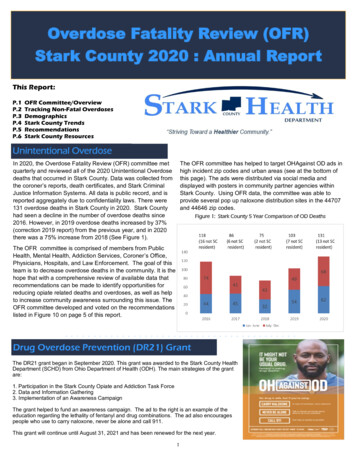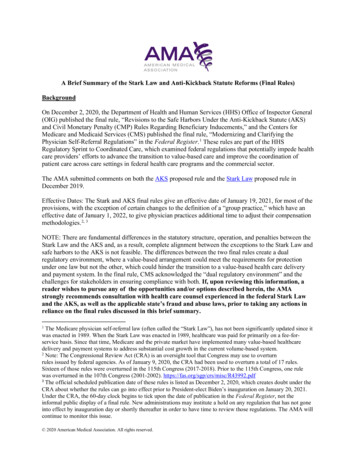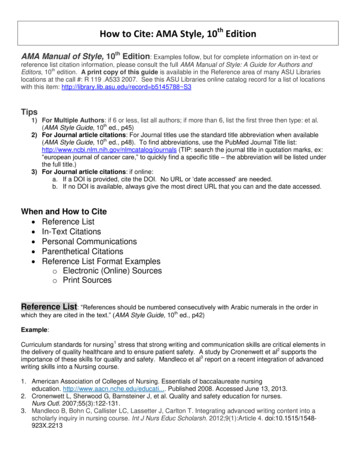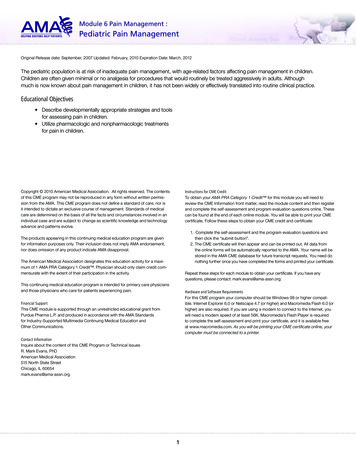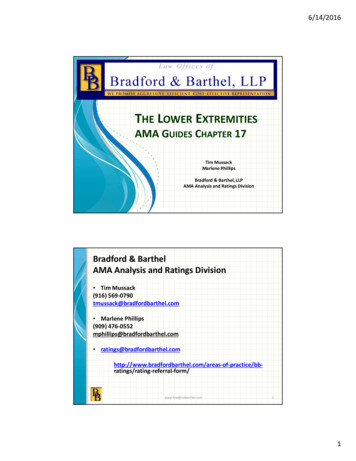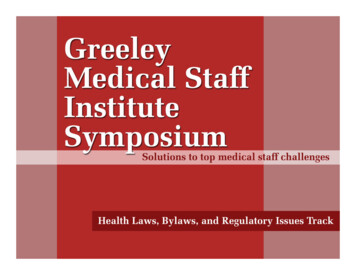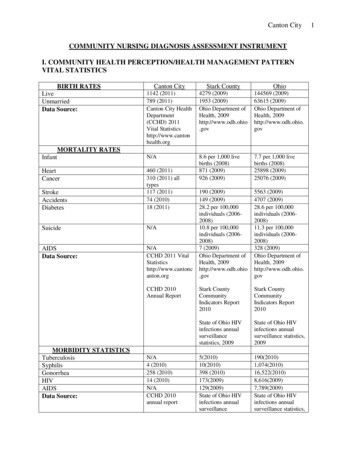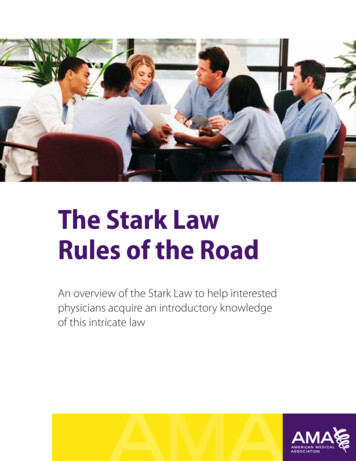
Transcription
The Stark LawRules of the RoadAn overview of the Stark Law to help interestedphysicians acquire an introductory knowledgeof this intricate law
Rules of the Road—how physicians can navigate the Stark LawI. Purpose of this document1.1 What is the purpose of this “Rules of the Road” document? The Stark statuteand regulations (collectively referred to as the “Stark Law”) significantly restrictsphysician referral patterns and limits many but not all types of business relationshipsinto which physicians may enter. This “Rules of the Road” document discusses manyof the key requirements of and exceptions to the Stark Law, as the AMA understandsthem to currently exist, and highlights areas where physicians retain flexibility.1.2 This document is intended only to be an introduction to certain aspects of theStark Law. This document is intended to help interested physicians acquire anintroductory knowledge of the Stark Law. This document does not describe all of theStark Law’s aspects—even in an introductory manner. The Stark Law iscomplicated, and its application in any specific situation is heavily dependent on thefacts of that unique situation. Instead, this document discusses, through exampleswhere appropriate, some of the aspects of the Stark Law that may be most germane tothe types of transactions and business relationships in which physicians mostfrequently find themselves involved.1.3 Legal disclaimer. This document is intended to provide only general informationabout the Stark Law based on the AMA’s current understanding. The examplesdiscussed are illustrative only and should not be used as a basis for determiningcompliance with the Stark Law. The AMA provides this document with the expressunderstanding that this document does not create an attorney-client relationshipbetween the AMA and the reader, and the AMA is not providing legal advice. Thereader should seek legal advice from retained legal counsel when assessingcompliance with the Stark Law (including assessing changes in the Stark Law orother developments since the preparation of this document.)II. What is the Stark Law and what does it prohibit?2.1 The Stark Law’s initial prohibition applied only to clinical lab services. TheStark Law, also known as the Ethics in Patient Referrals Act of 1989 (the Act),became effective on January 1, 1992.1 The Act, as amended over time along with itsassociated regulations, is frequently referred to as the “Stark Law” becauseCongressman Pete Stark sponsored the bill that ultimately became the Act. On itseffective date, the Stark Law (Stark I) prohibited physicians from ordering clinicallaboratory services for Medicare patients from an entity with whom the physician (oran immediate family member of that physician) had a “financial relationship.”2.2 The Stark Law prohibition today applies to a broader range of “designatedhealth services.” Effective January 1, 1995, the Stark Law’s prohibition was1The Stark statute is located at 42 USC § 1395nn and the regulations at 42 CFR § 411.350 et seq.
2expanded to include other services in addition to clinical laboratory services (StarkII). Currently, the Stark Law prohibits:(1) a physician from referring Medicare patients to entities for the provision ofdesignated health services (DHS) if the physician (or an immediate familymember) has a direct or indirect financial relationship with that entity; 2 and(2) an entity that furnishes DHS pursuant to a prohibited referral from billing theMedicare program or any individual, third party payer, or other entity for theDHS.3This document discusses DHS in detail in VII.III. What happens if the Stark Law is violated?3.1 Denial of payment. The Medicare program is prohibited from paying for DHSfurnished pursuant to a prohibited referral. 43.2 Refund of payments. Any entity that that collects a payment for DHS that wasperformed pursuant to a prohibited referral must timely refund such payment.53.3 Imposition of civil monetary penalties by the Centers for Medicare andMedicaid Services (CMS). Any person or entity who bills Medicare for a DHS thatthe person or entity knew, or should have known, resulted from a prohibited referralis subject to a civil money penalty of not more than 15,000 for each such service. 63.4 Assessment of a penalty by the Office of the Inspector General (OIG) of theU.S. Department of Health and Human Services (DHHS). Any person or entitywho bills Medicare for DHS that the person or entity knew, or should have known,resulted from a prohibited referral is also subject to an assessment by the OIG of threetimes the amount claimed for the DHS.73.5 Civil monetary penalty for involvement in a circumvention scheme. Anyphysician or other entity that enters into an arrangement or scheme (such as a crossreferral arrangement) that the physician or entity knows or should know has a242 USC § 1395nn(a)(1)(A); 42 CFR § 411.350(a), 42 CFR § 411.353(a)342 USC § 1395nn(a)(1)(B); 42 CFR § 411.353(b)442 USC § 1395nn(g)(1); 42 CFR § 411.353(c)(1)542 USC § 1395nn(g)(2)642 USC § 1395nn(g)(3)7See 42 CFR § 1003.100(b)(viii)Copyright 2011 American Medical Association. All rights reserved.
3principal purpose of assuring referrals by the physician to a particular entity which, ifthe physician directly made referrals to such entity, would violate the Stark Law, issubject to a civil money penalty of not more than 100,000 for each such arrangementor scheme. 83.5.1 Example of a possible circumvention scheme. Suppose Physician A hasan ownership interest in an independent diagnostic treatment facility (IDTF 1).Suppose also that Physician A is not permitted under the Stark Law to referMedicare patients to the IDTF 1 for the provision of DHS. Suppose thatPhysician B practices in the same town as Physician A and also has an ownershipinterest in another IDTF (IDTF 2) to which she is not permitted to refer Medicarepatients for the provision of DHS. Finally, suppose that the Stark Law does notprohibit Physician A from referring to IDTF 2 and Physician B is not prohibitedfrom referring to IDTF 1. Physicians A and B would enter into a prohibitedcircumvention scheme if Physician A agreed to refer all of his/her Medicarepatients to IDTF 2 in exchange for Physician B agreeing to refer all of his/herMedicare patients to IDTF 1.3.6 Exclusion from Federal health care programs. A violation of the Stark Lawcan result in exclusion from federal health care programs.9IV. When does a “referral” occur?4.1 The Stark Law only applies to a physician when he or she makes a“referral.” The Stark Law does not apply to all physician activities. Instead, theStark Law only applies when a physician has made a “referral,” as defined by theStark Law. Accordingly, in terms of deciding whether or not the Stark Law applies,the physician must ask whether or not he or she is making Stark Law referrals.4.2 What is a referral? The following describe the different types of conduct thatconstitute, and do not constitute “referrals” under the Stark Law.4.2.1 A referral is a request, order, or certification. A “referral” is the requestby a physician for, the ordering of, or the certifying or recertifying of the need for,any DHS, including the request for a consultation with another physician and anytest or procedure ordered by or to be performed by (or under the supervision of)that other physician. A “referral” does not include DHS personally performed orprovided by the referring physician.10842 USC § 1395nn(g)(4)942 USC § 1395nn(g)(3) and (4)1042 USC § 1395nn(h)(5)(A); 42 CFR § 411.351Copyright 2011 American Medical Association. All rights reserved.
44.2.2 A referral is also the establishment of a plan of care. A referral is alsothe establishment of a plan of care by a physician that includes the provision ofDHS, but again, does not include any DHS personally performed or provided bythe referring physician.114.2.3 Conduct that does not constitute a “referral.” The Stark Law exceptsspecific types of conduct from the definition of “referral.” If a physician’sconduct falls within the categories described in the following subsections, thephysician has not made a referral and the Stark Law does not apply.4.2.3.1 A physician personally performing a DHS does not constitute a“referral.” A referral does not occur when a referring physician personallyperforms the DHS.12(1) Example of a DHS that is personally performed by a physician.Suppose a physician examines a patient and determines that the patientrequires an antigen to treat an allergic reaction. The physician would notmake a referral for the provision of that antigen if the physician personallyadministered the antigen to the patient.13 However, if the antigen wereadministered by another physician in the referring physician’s grouppractice, the provision of the antigen would occur pursuant to a referral(although the referral could potentially fit into the Stark Law physicianservices or in-office ancillary services exceptions.)144.2.3.2 Certain requests by pathologists, radiologists, or radiationoncologists are not “referrals.” A request by a pathologist for clinicaldiagnostic laboratory tests and pathological examination services, a request bya radiologist for diagnostic radiology services, and a request by a radiationoncologist for radiation therapy or ancillary services necessary for, andintegral to, the provision of radiation therapy, are not referrals if:(1) the request results from a consultation initiated by another physician;and(2) the tests or services are furnished by or under the supervision of thepathologist, radiologist, or radiation oncologist, or under the supervisionof a pathologist, radiologist, or radiation oncologist, respectively, in the1142 USC § 1395nn(h)(5)(B); 42 CFR § 411.3511242 CFR § 411.351.1369 FR 16054, 16063; See 69 FR 1607014See 69 FR 16070Copyright 2011 American Medical Association. All rights reserved.
5same group practice as the pathologist, radiologist, or radiationoncologist.154.2.3.3 What if a physician writes an order for DHS but doesnot direct where the Medicare beneficiary should receive thoseDHS? It appears that in certain circumstances, a physician’sordering a DHS may not constitute a “referral” even if theMedicare beneficiary receives those DHS from an entity withwhich the physician has a financial relationship. Commentaryfrom CMS seems to suggest that the ordering physician does notsuggest or otherwise influence where the patient receives theordered DHS, and the Medicare beneficiary obtains the DHS froman entity with whom the physicians has a compensationarrangement, the physician will not have made a “referral” to thatentity.16V. If a referral occurred, did the physician make the referral?5.1 A physician can make a referral even if he or she is not the one who orders orrequests the DHS. A physician can make a Stark Law referral even if he or she doesnot actually order or request the DHS, depending on the extent to which the physiciancontrols those who are performing the ordering or requesting.5.1.1 Example illustrating how a referral may be attributed to a physicianeven if the physician did not actually make the referral. Suppose a physicianassistant who works in a physician’s practice refers a patient to a particularimaging facility because the physician has instructed her clinical staff to refercertain diagnostic procedures to that facility. Because the referral would be madepursuant to the physician’s instructions, i.e., pursuant to the physician’s control,CMS would treat the physician assistant’s referral as if the physician herself madethe referral.17VI. Are the referred items or services for a Medicare beneficiary?6.1 The Stark Law only applies when the referral concerns a Medicarebeneficiary. If the patient involved is not a Medicare beneficiary, then the Stark Lawdoes not apply.1542 USC § 1395nn(h)(5)(C); 42 CFR § 411.3511666 FR 856, 87317See e.g., the discussion at 66 FR 900Copyright 2011 American Medical Association. All rights reserved.
6VII. Is the referral for DHS?7.1 The Stark Law only applies to referrals for DHS. The Stark Law does notapply to all health care services. The Stark Law only applies to referrals for DHS.7.1.1 Example of a referral not involving a DHS. Suppose a physician refers aMedicare patient to a hospital in order to receive lithotripsy services. Thephysician would not have made a referral for DHS, because lithotripsy is notDHS.187.2 What is a “designated health service?” DHS includes any of the followingservices:(1) clinical laboratory services;(2) physical therapy, occupational therapy, and outpatient speech-languagepathology services;(3) radiology and certain other imaging services, except for the following, whichare not considered to be DHS(a) X-ray, fluoroscopy, or ultrasound procedures that require the insertion of aneedle, catheter, tube, or probe through the skin or into a body orifice;(b) radiology or certain other imaging services that are integral to theperformance of a medical procedure that is not identified on the list ofCPT/HCPCS codes as a radiology or certain other imaging service and isperformed:(i) immediately prior to or during the medical procedure; or(ii) immediately following the medical procedure when necessary toconfirm placement of an item placed during the medical procedure.radiology and certain other imaging services that are "covered ancillaryservices," as defined at 42 CFR § 416.164(b), for which separate paymentis made to an ambulatory surgery center;(4) radiation therapy services and supplies;(5) durable medical equipment and supplies;(6) parenteral and enteral nutrients, equipment, and supplies;(7) prosthetics, orthotics, and prosthetic devices and supplies;1873 FR 48719. See also American Lithotripsy Society v. Thompson, 215 F. Supp. 2d 23 (D.D.C. 2002).Copyright 2011 American Medical Association. All rights reserved.
7(8) home health services;(9) outpatient prescription drugs; and(10) inpatient and outpatient hospital services.197.3 “Designated Health Services” does not include services that are reimbursedas part of a composite rate. Generally, “DHS” does not include services that arereimbursed by Medicare as part of a composite rate (for example, ASC services,except to the extent that services listed section 7.2(1) – (10) above are themselvespayable through a composite rate (for example, all services provided as home healthservices or inpatient and outpatient hospital services are DHS).20.7.4 DHS includes professional and technical components. Some DHS, such asdiagnostic imaging tests, have both a technical component (the performance of thetest itself) and a professional component (the interpretation of the test). Both thetechnical and professional components of a DHS are themselves DHS.217.5 Health care services that are not DHS when furnished outside of inpatientand outpatient settings may be transformed into DHS when furnished in thosesettings. One potential trap concerning DHS and the Stark Law can occur when ahealth care service that is not a DHS outside of the hospital setting becomes a DHSwhen provided in the hospital setting.7.5.1 Example illustrating how a non-DHS can be transformed into a DHS inthe hospital setting. Diagnostic cardiac catheterization services are not DHSwhen provided outside of the hospital outpatient or inpatient context. Suchservices do become DHS when they are furnished in a hospital inpatient oroutpatient setting because inpatient and outpatient hospital services are DHS.227.6 How can a physician know if a particular service is a DHS? CMS definessome DHS through specific CPT and HCPCS codes on its Website. CMS publishes alist that defines all DHS under the following categories in terms of specificCPT/HCPCS codes: (1) clinical laboratory services; (2) physical therapy services,occupational therapy services, outpatient speech-language pathology services; (3)radiology and certain other imaging services; and (4) radiation therapy services andsupplies. These CPT/HCPCS codes can be accessed at1942 USC § 1395nn(h)(6); 42 CFR § 411.3512042 CFR § 411.351; see e.g., the discussion starting at 69 FR 1611121For example, see the discussion at 66 FR 92422See e.g., 66 FR 929Copyright 2011 American Medical Association. All rights reserved.
8http://www.cms.gov/PhysicianSelfReferral/40 List of Codes.asp. The remainingcategories of DHS are not defined through specific CPT or HCPCS codes.VIII. Is the referral to an “entity that furnishes DHS”? Even if a (1) physician (2)makes a referral (3) for DHS (4) for a Medicare beneficiary, the Stark Law does notapply unless the DHS are furnished by an “entity” that furnishes DHS.8.1 What is an “entity?” The term “entity” itself is defined broadly. It can, forexample, be a solo or group practice medical practice. But “entity” can also be acorporation, partnership, limited liability company, foundation, nonprofit corporation,or unincorporated association that furnishes DHS. So an “entity” could include aphysician professional association, a hospital, a nursing facility, an independentdiagnostic treatment facility.238.2 What is an “entity that furnishes DHS?” There are two types of entities that“furnish DHS.”8.2.1 An “entity that furnishes DHS” can be an entity or person that bills theMedicare program for DHS services. An entity that furnishes DHS is an entityor person that bills the Medicare program for DHS.248.2.1.1 Examples of entities that bill Medicare for the provision of DHS.All of the following would constitute “entities furnishing DHS”: a hospitalbilling the Medicare program for the provision of a CT scan; a solo physicianpractitioner billing the Medicare program for administering drugs in her or heroffice; a medical practice billing Medicare for an interpretation of an MRIscan performed by one of the group’s physician members.8.2.2 An “entity that furnishes DHS” can be an entity or person that performsDHS services that are billed to the Medicare program. Effective October 1,2009, CMS expanded the definition of “entity that furnishes DHS” to includethose persons or entities that perform DHS, even if another person or entity billsthe Medicare program for those DHS.258.2.2.1 Example of an entity that performs, but does not bill, theMedicare program. Suppose a hospital wishes to provide cardiaccatheterization (CC) services to its patients, but does not own the equipment.A physician group practice in town does, however, own CC equipment.Rather than purchasing the CC equipment and providing those services itself,the hospital and the group practice enter into an “under arrangements”2342 CFR § 411.3512442 CFR § 411.3512542 CFR § 411.351; See also the discussion beginning at 73 FR 48721Copyright 2011 American Medical Association. All rights reserved.
9transaction by, for example, creating a joint venture which would own the CCequipment. The hospital would purchase the cardiac catheterization servicesfor its patients from the joint venture and bill the Medicare program for thoseservices. The group practice would furnish all of the equipment, personnel,and supplies necessary to provide those services through the joint venture, andwould refer Medicare patients to the joint venture. Because of the expansionof the definition of “entity that furnishes DHS” to include an entity or personthat performs DHS, the joint venture would be considered a DHS entity, inaddition to the hospital.268.2.2.2 So what does it mean to “perform” a DHS? CMS has not definedthe word “performs.” CMS has stated, however, that:“We do not consider an entity that leases or sells space orequipment used for the performance of the service, or furnishessupplies that are not separately billable but used in the performanceof the medical service, or that provides management, billingservices, or personnel to the entity performing the service, toperform DHS.”27(1) Example of an arrangement involving physicians that would notappear to cross the “performs” threshold. Suppose a physician grouppractice owns a mobile CT scanner. The practice leases the use of thescanner to a local hospital one day a week, and hospital staff performs thetests using the scanner while it is at the hospital. In such a case, thepractice would not become a DHS entity by leasing the scanner to thehospital because leasing in and of itself does not constitute theperformance of DHS. In the final Medicare Physician Fee Schedule for2010, CMS acknowledged that it had received numerous questionsconcerning the meaning of “performs” and solicited comments concerningwhether or not it should define or clarify this phrase, and if so, how. CMShas yet to provide further clarification.28IX. Does the physician or the physician’s “immediate family member” have a“financial relationship” with the entity furnishing DHS services? Even if a physician(1) makes a referral of (2) a Medicare beneficiary for (3) DHS to (4) an entity thatfurnishes DHS, the Stark Law may not apply. In order for the Stark Law to beapplicable, a “financial relationship” must exist between the physician or the physician’simmediate family member and the entity that furnishes DHS (subsequently forconvenience referred to as “entity”). And, even if a financial relationship exists between26See the discussion starting at 73 FR 487212773 FR 487262874 FR 61933-61934Copyright 2011 American Medical Association. All rights reserved.
10the physician or the physician’s family member and the entity, the Stark Law will notapply if a Stark Law exception applies.9.1 There are four kinds of “financial relationships.” There are four types offinancial relationships: (1) direct ownership/investment interests; (2) indirectownership/investment interests; (3) direct compensation arrangements; and (4)indirect compensation arrangements. Understanding the nature of the financialrelationship involved is vital because the nature of the financial relationshipdetermines what, if any, Stark Law exceptions may apply.299.2 Stark Law financial relationships may exist not only between physicians andentities but also between a member of the physician’s immediate family and theentity. The Stark Law defines an “immediate family member” to include aphysician’s: husband or wife; birth or adoptive parent, child, or sibling; stepparent,stepchild, stepbrother, or stepsister; father-in-law, mother-in-law, son-in-law,daughter-in-law, brother-in-law, or sister-in-law; grandparent or grandchild; andspouse of a grandparent or grandchild.30 A financial relationship involving anyperson falling under one of the aforementioned categories will trigger the Stark Lawprohibition.9.2.1 Example illustrating a financial relationship between a physician andan entity created via a family member. Suppose a physician in solo practicehas her office in a building owned by her and six other physicians, one of whomis her step brother. The building contains a laboratory that is owned by a grouppractice in which the step brother is a shareholder. The Stark Law would prohibither from referring Medicare beneficiaries to the lab for the provision of DHSunless the financial relationship between the lab and the physician’s step brothermet the requirements of a Stark Law exception.319.3 What is an ownership or investment interest? An ownership or investmentinterest in an entity furnishing DHS can be through equity, debt, stock, partnershipshares, limited liability company memberships, as well as loans, bonds, or otherfinancial instruments that are secured with an entity's property or revenue, or aportion of that property or revenue.329.3.1 What is a direct ownership/investment interest? A directownership/investment interest exists when there is no intervening2942 USC § 1395nn(a)(2); 42 CFR § 411.354(a)(1)3042 CFR § 411.35131See 60 FR 41938-419393242 USC § 1395nn(a)(2); 42 CFR § 411.354(b)(1)Copyright 2011 American Medical Association. All rights reserved.
11ownership/investment interest between the physician (or immediate familymember) and the entity.339.3.1.1 Examples illustrating direct ownership/investment interests. Aphysician shareholder in a physician group would have a directownership/investment interest in an entity if the group practice billed theMedicare program for providing DHS services, e.g., physical therapy services.A physician would also have a direct ownership/investment interest in anentity if the physician owned stock in a for-profit general acute care hospitalor in an IDTF that served Medicare beneficiaries.9.3.2 What is an indirect ownership or investment interest? An indirectownership or investment interest exists if the following two requirements aresatisfied.9.3.2.1 Does an unbroken chain of ownership/investment interests existbetween the physician and the entity? There must exist between thephysician (or family member) and the entity an unbroken chain of any number(but no less than one) of persons or entities having ownership or investmentinterests.34(a) Example of an unbroken chain of ownership/investment interests.Suppose a physician’s step-daughter has an ownership interest in a localnursing home. The nursing home in turn owns a portion of a corporationthat provides durable medical equipment (DME). An unbroken chain ofownership/investment interests exists between the step-daughter and theDME corporation, because the stepdaughter has a directownership/investment interest in the nursing home, and the nursing homehas an ownership/investment interest in the DME corporation. 359.3.2.2 The DHS provider must “know” that the referring physician orthe physician’s family member has an ownership or investment interest inthe entity. The entity must have actual knowledge of, or act in recklessdisregard or deliberate ignorance of, the fact that the referring physician (orfamily member) has some ownership/ investment interest (through anynumber of intermediary ownership or investment interests) in the entity.36(1) To what extent is an entity responsible for investigating whether areferring physician (or family member of that physician) has an3342 CFR § 411.354(a)(2)(i)3442 CFR § 411.354(a)(5)(i)(A); 42 CFR § 411.354(a)(5)(iv)35Other examples and further discussion can be found starting at 69 FR 160573642 CFR § 411.354(a)(5)(i)(B)Copyright 2011 American Medical Association. All rights reserved.
12indirect ownership or investment interest in the entity? The“knowledge” requirement of section 9.3.2.2 does not require an entity toaffirmatively investigate every possible indirect ownership or investmentinterest that a referring physician may have with the entity. Instead, anentity has a duty to make a reasonable inquiry concerning a possible indirectownership or investment interest if the entity learns of facts that would makea reasonable person suspect that such an indirect ownership/investmentexists.379.3.3 Ownership in a subsidiary company does not create an ownershipinterest in the parent company. If a physician has an ownership or investmentinterest in a subsidiary company, that ownership or investment interest does notcreate an ownership or investment interest in the parent company, or in any othersubsidiary of the parent, unless the subsidiary company itself has an ownership orinvestment interest in the parent or such other subsidiaries. The ownership ofinvestment interest in the subsidiary may, however, be a part of an indirectfinancial relationship.389.3.4 Common ownership in an entity by itself does not create an ownershipor investment interest in another common owner. If a physician has acommon ownership or investment interest in an entity, that interest does not, inand of itself, establish an indirect ownership or investment interest by thephysician in another common owner, or investor.399.4 What is a compensation arrangement? A “compensation arrangement” is anyarrangement involving remuneration, direct or indirect, between a physician (orfamily member) and an entity.40 The term "remuneration" includes any remuneration,directly or indirectly, overtly or covertly, in cash or in kind.41 The Stark statute andregulations list a few limited circumstances that do not constitute “remuneration” forpurposes of the Stark Law.429.4.1 What is a direct compensation arrangement? A direct compensationarrangement exists if remuneration passes between the referring physician (or3766 FR 856, 8653842 CFR § 411.354(b)(2)3942 CFR § 411.354(b)(5)(iii)4042 USC § 1395nn(h)(1)(A)4142 USC § 1395nn(h)(1)(B).4242 USC § 1395nn(h)(1)(c); 42 CFR § 411.351Copyright 2011 American Medical Association. All rights reserved.
13family member) and the entity furnishing DHS without any intervening persons orentities.439.4.1.1 Examples of direct compensation arrangements. The followingwould all constitute direct compensation arrangements between a physicianand an entity:(1) a nursing home paying a physician via an independent contractorrelationship to serve as the nursing home’s medical director;(2) a physician renting office space from a hospital;(3) a hospital renting equipment from a physician;(4) a hospital directly employing a physician.9.4.2 What is an indirect compensation arrangement? An indirectcompensation arrangement exists between a referring physician (or familymember) and an entity if the following apply.449.4.2.1 Does an unbroken chain of any number (but not less than one) offinancial relationships exist between the physician and the entity? Anunbroken chain of financial relationships must exist between the physician (orfamily member) and the DHS entity. At least one of these financialrelationships must be a compensation arrangement. However, so long as oneof the financial relationships in the unbroken chain is a compensationarrangement, it does not matter if the other financial relationships are direct orindirect ownership interests.45(1) Example of an unbroken chain of at least two financialrelationships. Suppose a physician owns stock in a for-profit hospital.The hospital contracts with a clinical laboratory to provide specificlaboratory se
2.2 The Stark Law prohibition today applies to a broader range of "designated health services." Effective January 1, 1995, the Stark Law's prohibition was 1 The Stark statute is located at 42 USC § 1395nn and the regulations at 42 CFR 411.350 et seq.
